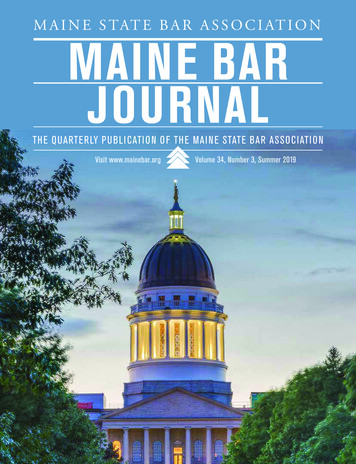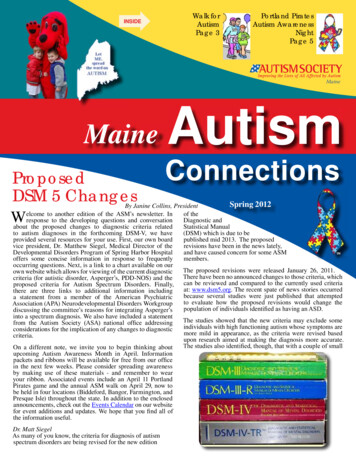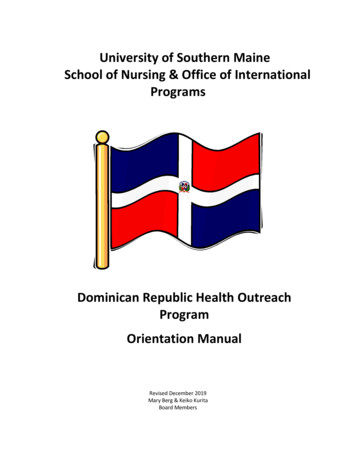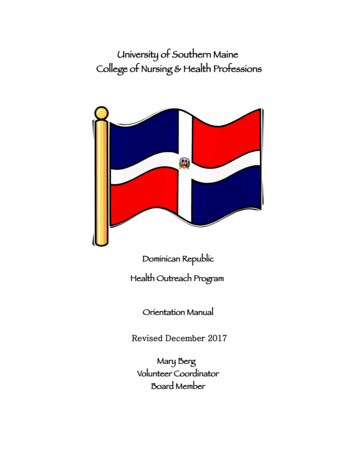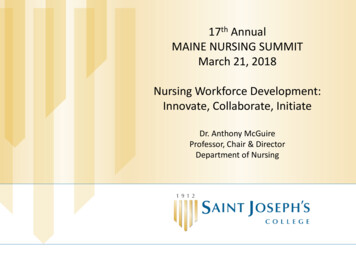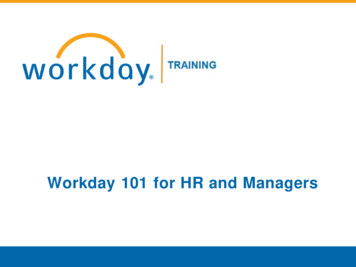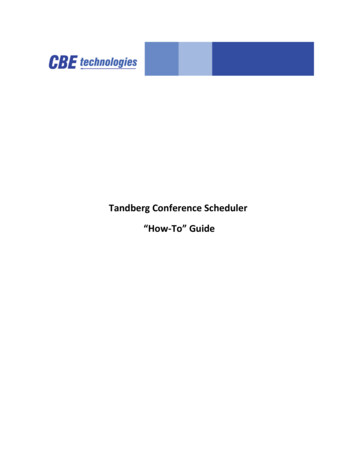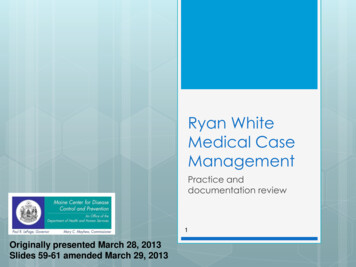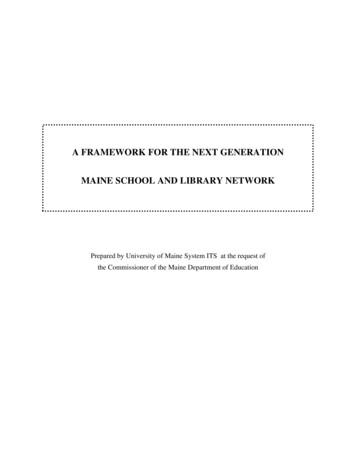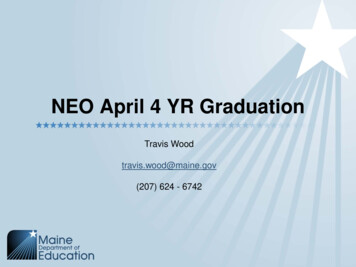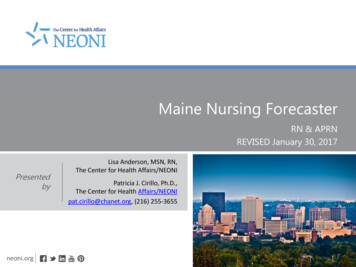
Transcription
Maine Nursing ForecasterRN & APRNREVISED January 30, 2017Presentedbyneoni.orgLisa Anderson, MSN, RN,The Center for Health Affairs/NEONIPatricia J. Cirillo, Ph.D.,The Center for Health Affairs/NEONIpat.cirillo@chanet.org, (216) 255-3655The Center for Health Affairsworkforce initiative
ProjectMethodologySupply: Maine’sNurse WorkforceBringing it Together– How FutureSupply & DemandWill TrendDemand: Maine’sMaine’sPopulationsQuestions andAnswersThe Center for Health Affairs workforce initiative, NEONI
Maine’s Regions Definition of ‘region’ is where mostpatients live and where most of theworkforce lives. Seven Regions York/Cumberland iscataquis/PenobscotAroostookThe Center for Health Affairs workforce initiative, NEONI
Data Sources Nurse registration data, 2015– In Maine, nurses licenses are renewed before their birthdays, and expireafter two years.– Nurses renew their licenses based on their year of birth (odd or evennumbered year).– The ‘Minimum Data Set,’ captured during the renewal process, is a richsource of information on nurses, including key information needed for aforecast (age, working status, work setting, area of practice, county ofresidence and county of employment). The State of Maine provides population projection estimates Hospital annual reports provide volume statistics which allow us to estimatethe number of nurses needed, for hospital care, based on population size.The Center for Health Affairs workforce initiative, NEONI
Maine’s NurseWorkforceThe Center for Health Affairs workforce initiative, NEONI
Maine’s Nurse Workforce In 2015, there were approximately27,000 (RNs/APRNs/LPNs). 85.8% of all licensees are working. The great majority are RNs (85.3%). LPN programs have all closed, andLPN workforce is expected to be verysmall by 2027.The Center for Health Affairs workforce initiative, NEONI
Maine’s PopulationThe Center for Health Affairs workforce initiative, NEONI
Maine’s Population120,000 What a difference ten years will make.Maine Population, By Age Groups, 2017 - 2027100,00080,00060,00040,000Somewhat similar in 2017 and 202720,000Very different story for older cohorts:Significantly more people aged 65 in2027 than in 2017.00-45-910-14 15-19 20-24 25-29 30-34 35-39 40-44 45-49 50-54 55-59 60-64 65-69 70-74 75-79 80-8420172027The Center for Health Affairs workforce initiative, NEONI
Same issue among the RN Workforce 30% of the current RN (FTE) workforce is between the age of 55 and 64.000 There are currently about 8,000 RNs which need to eventually take the place ofapproximately 11,000 RNs.Age Group of RN 000-2015 3535-4445-5455-6465 The Center for Health Affairs workforce initiative, NEONI
IMPACT OF AGE ON INPATIENTDEMAND – Hospital Setting10
Orientation to ModelThe Center for Health Affairs workforce initiative, NEONI
Timeframe of Model 2015 is the ‘baseline’– The most recent supply data for RNs We project to 2027 because the State’sdemographers report population projections for fiveyear periods: 2017, 2022, and 2027.The Center for Health Affairs workforce initiative, NEONI
What the model accounts for . There is a separate model for each region and results aresummed to create the totaled state projections. Number of newly licensed nurseseach year Retention rates and FTEequivalence Number of nurse recruits into eachregion ‘Export rate’ (providing care tothose outside of region) Utilization Factors (variable byhealthcare setting) Population demographics Population Migration (into theregion) Nurse workforce demographics,work patterns [updated each year] Number of new (net) hospital bedsanticipated Proportion of healthcare which isprovided in hospitals, vs. LTC vs.homecare, etc.The Center for Health Affairs workforce initiative, NEONI
“Demand Factors”Demand Factors Based on2015 Nurse Registration DataSettingInpatient/Per patient daysEmergency Visits/1,000 peopleAmbulatory Visits/ per dayNursing Facilities/1,000 peopleHome Health/1,000 peopleThese will likely changein the next several years.Community Health*Public Health*Nursing Education**Estimated from nurse registrations and 2010census*Based on widely-used HRSA figuresThe Center for Health Affairs workforce initiative, NEONI
Dynamic vs. Static ModelThis is a forecasting tool, nota forecast. That is, we knowthat demand for healthcarecan shift, sometimesdramatically, over time, sothe tool accommodates that.Trends in healthcare (newtreatments, technologies),economic conditions andpatient acuity all play a partin the demand for healthcare.Therefore, this tool isdesigned to allow foradjustments of theassumptions to reflectchanges in demand (andsupply).The Center for Health Affairs workforce initiative, NEONI
The Basic Math Behind The ModelSupply ModelHow Many NursesWe HaveNumber of newlylicensed nurses(RNs and APRNs)Demographics of thenurse workforce(in particular, age)Work patterns of thenurse workforce(in particular, the numberof hours worked)Demand ModelHow Many NursesWe NeedSize of the populationAmount of healthcare(by setting) requiredby the populationNumber of nursesrequired to provide each‘unit’ of healthcareTrends in healthcare,economic conditions,patient acuityThe Center for Health Affairs workforce initiative, NEONI
How Does One Use The Model?Within each model, there are “input cells” where the usercan make changes to the various factors in order to viewwhat sort of impact those changes have on thesupply/demand gap. This is what makes this modeling process different than most. We did notjust predict numbers, we created a tool where you can predict the future ifsomething unexpected happens. This model is designed to be used for thenext 10 years.The Center for Health Affairs workforce initiative, NEONI
Model Characteristics and FunctionExcelPlatformAdjustableSettings Spreadsheet series of databases connected by uniquemathematical relationships. Several settings that can beadjusted to create supply anddemand hypothetical situationsThe Center for Health Affairs workforce initiative, NEONI
Simulations: ExamplesHow many new nurseswould we need toeducate to avoid ashortage?What if a population in aregion experiences alarge shift (in size or incomposition)?What if employers areusing those nursedifferently?What if nurses retire at adifferent rate? Leave theregion at a different rate?The Center for Health Affairs workforce initiative, NEONI
The Center for Health Affairs workforce initiative, NEONI
Maine Nursing Forecaster RN & APRN REVISED January 30, 2017 Presented by. The Center for Health Affairs workforce initiative, NEONI Project Methodology Supply: Maine’s Nurse Workforce Demand: Maine’s Maine’s Populat
